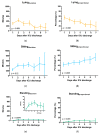Objective Quantification of In-Hospital Patient Mobilization after Cardiac Surgery Using Accelerometers: Selection, Use, and Analysis
- PMID: 33799717
- PMCID: PMC7999757
- DOI: 10.3390/s21061979
Objective Quantification of In-Hospital Patient Mobilization after Cardiac Surgery Using Accelerometers: Selection, Use, and Analysis
Abstract
Cardiac surgery patients infrequently mobilize during their hospital stay. It is unclear for patients why mobilization is important, and exact progress of mobilization activities is not available. The aim of this study was to select and evaluate accelerometers for objective qualification of in-hospital mobilization after cardiac surgery. Six static and dynamic patient activities were defined to measure patient mobilization during the postoperative hospital stay. Device requirements were formulated, and the available devices reviewed. A triaxial accelerometer (AX3, Axivity) was selected for a clinical pilot in a heart surgery ward and placed on both the upper arm and upper leg. An artificial neural network algorithm was applied to classify lying in bed, sitting in a chair, standing, walking, cycling on an exercise bike, and walking the stairs. The primary endpoint was the daily amount of each activity performed between 7 a.m. and 11 p.m. The secondary endpoints were length of intensive care unit stay and surgical ward stay. A subgroup analysis for male and female patients was planned. In total, 29 patients were classified after cardiac surgery with an intensive care unit stay of 1 (1 to 2) night and surgical ward stay of 5 (3 to 6) nights. Patients spent 41 (20 to 62) min less time in bed for each consecutive hospital day, as determined by a mixed-model analysis (p < 0.001). Standing, walking, and walking the stairs increased during the hospital stay. No differences between men (n = 22) and women (n = 7) were observed for all endpoints in this study. The approach presented in this study is applicable for measuring all six activities and for monitoring postoperative recovery of cardiac surgery patients. A next step is to provide feedback to patients and healthcare professionals, to speed up recovery.
Keywords: LOO cross-validation; activity classification; biomedical signal processing; early ambulation; k-fold cross validation; patient monitoring; thoracic surgery; wearable technology.
Conflict of interest statement
The authors declare no conflict of interest. The funder had no role in the design of the study; in the collection, analyses, or interpretation of data; in the writing of the manuscript, or in the decision to publish the results.
Figures




Similar articles
-
A mobilization poster stimulates early in-hospital rehabilitation after cardiac surgery: a prospective sequential-group study.J Cardiothorac Surg. 2023 Mar 9;18(1):83. doi: 10.1186/s13019-023-02173-w. J Cardiothorac Surg. 2023. PMID: 36895040 Free PMC article.
-
Identification and Quantification of Activities Common to Intensive Care Patients; Development and Validation of a Dual-Accelerometer-Based Algorithm.Sensors (Basel). 2023 Feb 3;23(3):1720. doi: 10.3390/s23031720. Sensors (Basel). 2023. PMID: 36772755 Free PMC article.
-
First initiation of mobilization out of bed after cardiac surgery - an observational cross-sectional study in Sweden.J Cardiothorac Surg. 2024 Jul 4;19(1):420. doi: 10.1186/s13019-024-02915-4. J Cardiothorac Surg. 2024. PMID: 38961385 Free PMC article.
-
Effectiveness of dexmedetomidine versus propofol on extubation times, length of stay and mortality rates in adult cardiac surgery patients: a systematic review and meta-analysis.JBI Database System Rev Implement Rep. 2018 May;16(5):1220-1239. doi: 10.11124/JBISRIR-2017-003488. JBI Database System Rev Implement Rep. 2018. PMID: 29762314
-
Use of wearable devices to monitor post-operative activity following cardiac surgery: a systematic scoping review.Eur J Cardiovasc Nurs. 2024 Oct 21;23(7):697-710. doi: 10.1093/eurjcn/zvae054. Eur J Cardiovasc Nurs. 2024. PMID: 38648510
Cited by
-
Treatment effect analysis of the Frailty Care Bundle (FCB) in a cohort of patients in acute care settings.Aging Clin Exp Res. 2024 Sep 10;36(1):187. doi: 10.1007/s40520-024-02840-5. Aging Clin Exp Res. 2024. PMID: 39254891 Free PMC article.
-
Monitoring postures and motions of hospitalized patients using sensor technology: a scoping review.Ann Med. 2024 Dec;56(1):2399963. doi: 10.1080/07853890.2024.2399963. Epub 2024 Sep 6. Ann Med. 2024. PMID: 39239877 Free PMC article.
-
Mobility level and factors affecting mobility status in hospitalized patients admitted in single-occupancy patient rooms.BMC Nurs. 2024 Jan 2;23(1):11. doi: 10.1186/s12912-023-01648-4. BMC Nurs. 2024. PMID: 38163905 Free PMC article.
-
Factors Determining the Functional State of Cardiac Surgery Patients with Complicated Postoperative Period.Int J Environ Res Public Health. 2022 Apr 4;19(7):4329. doi: 10.3390/ijerph19074329. Int J Environ Res Public Health. 2022. PMID: 35410009 Free PMC article.
-
A mobilization poster stimulates early in-hospital rehabilitation after cardiac surgery: a prospective sequential-group study.J Cardiothorac Surg. 2023 Mar 9;18(1):83. doi: 10.1186/s13019-023-02173-w. J Cardiothorac Surg. 2023. PMID: 36895040 Free PMC article.
References
-
- Koenders N., van Oorsouw R., Seeger J.P.H., Nijhuis-van der Sanden M.W.G., van de Glind I., Hoogeboom T.J. “I’m not going to walk, just for the sake of walking…”: A qualitative, phenomenological study on physical activity during hospital stay. Disabil. Rehabil. 2020;42:78–85. doi: 10.1080/09638288.2018.1492636. - DOI - PubMed
-
- Koenders N., Weenk M., van de Belt T.H., van Goor H., Hoogeboom T.J., Bredie S.J.H. Exploring barriers to physical activity of patients at the internal medicine and surgical wards: A retrospective analysis of continuously collected data. Disabil. Rehabil. 2019:1–7. doi: 10.1080/09638288.2019.1685013. - DOI - PubMed
MeSH terms
LinkOut - more resources
Full Text Sources
Other Literature Sources
Medical

